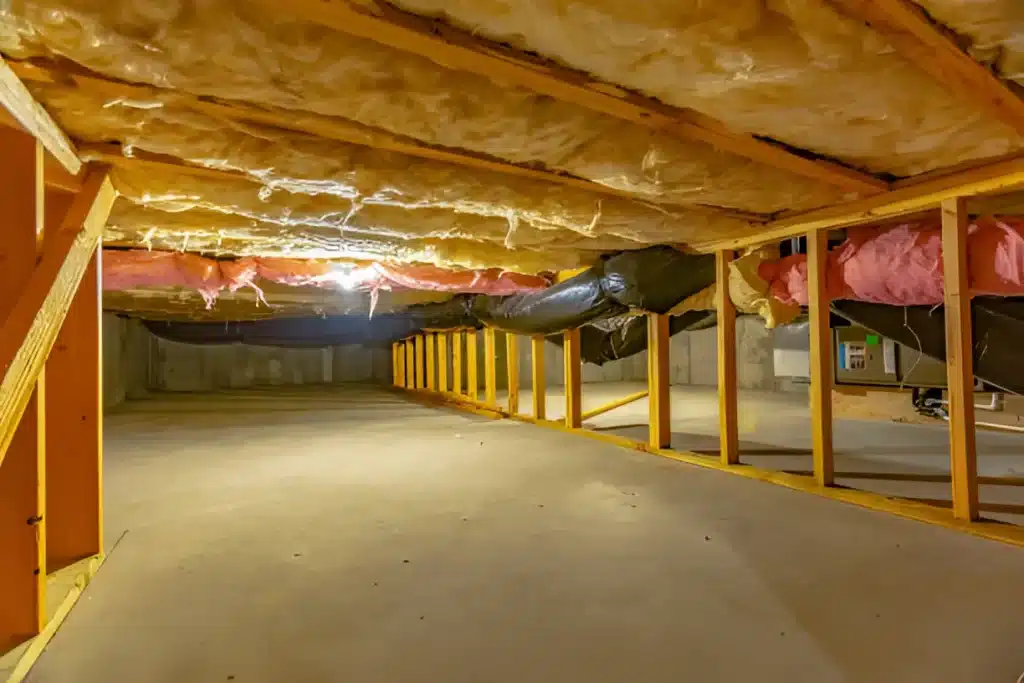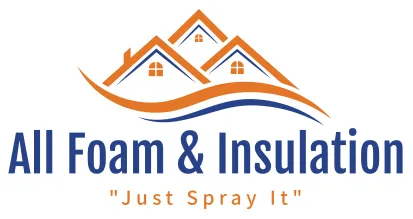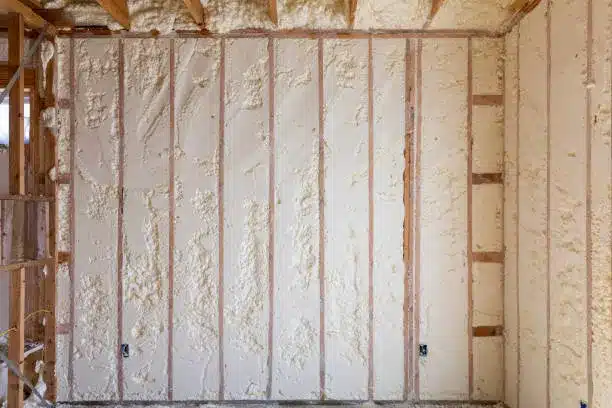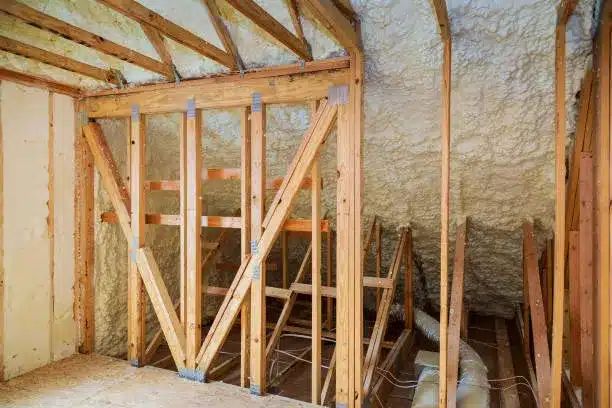Spray foam insulation provides higher thermal performance and air sealing compared to traditional options like fiberglass or blown-in cellulose. Closed-cell spray foam, in particular, creates a rigid, vapor-resistant barrier that significantly reduces energy loss and moisture infiltration.
Traditional insulation methods still serve many residential and commercial buildings effectively, but their lower R-value per inch, vulnerability to air gaps, and moisture absorption make them less efficient in some applications. Choosing between spray foam and traditional insulation depends on performance requirements, building design, and environmental conditions.
This content reflects direct field experience with insulation systems used across Oregon and the Pacific Northwest, where temperature shifts and moisture exposure require high-performing, durable insulation.
Key Differences Between Spray Foam and Traditional Insulation
| Feature | Spray Foam (Closed & Open Cell) | Fiberglass Batt | Blown-In Insulation |
|---|---|---|---|
| R-Value per Inch | 6.0 – 7.5 (Closed), 3.5 – 4.0 (Open) | 2.9 – 3.8 | 3.2 – 3.8 |
| Air Sealing | Excellent (closed-cell is airtight) | Poor | Moderate |
| Moisture Resistance | High (closed-cell is a vapor barrier) | Low | Moderate |
| Installation Location | Walls, ceilings, floors, attics | Walls, ceilings, floors | Attics, wall cavities |
| Structural Strength | Adds rigidity (closed-cell) | No structural benefit | No structural benefit |
| Mold Resistance | High (minimal moisture absorption) | Low to moderate | Moderate |
| Sound Dampening | Good (open-cell preferred) | Moderate | Good |
| Longevity | 20-30+ years | 10-25 years | 15-30 years |
Technical Specifications Snapshot
| Parameter | Closed-Cell Spray Foam | Open-Cell Spray Foam | Fiberglass Batt | Blown-In Insulation |
|---|---|---|---|---|
| R-Value per Inch | 6.0 – 7.5 | 3.5 – 4.0 | 2.9 – 3.8 | 3.2 – 3.8 |
| Density (lb/ft³) | 1.75 – 2.2 | 0.4 – 0.6 | 0.5 – 1.0 | 1.5 – 2.5 |
| Vapor Permeability | <1 perm (vapor barrier) | 10+ perms | 30 – 50 perms | 15 – 30 perms |
| Flame Spread Rating | Class I (most cases) | Class I | Varies | Varies |
Practical Applications by Climate
Oregon’s climate presents mixed insulation demands: cold winters, hot summers, and high precipitation. In such environments:
- Closed-cell spray foam: Performs best in basements, crawl spaces, and roof decks to resist moisture and insulate tight cavities.
- Open-cell spray foam: Open-cell is often used in attics or interior walls for sound dampening and thermal resistance without excessive rigidity.
- Fiberglass batt: Remain a cost-effective option for interior wall cavities but can settle or develop air gaps over time.
- Blown-in insulation: Works well in attic retrofits where non-disruption of existing finishes is a priority.

Things That Matter Before Choosing an Insulation Type
Choosing the right insulation isn’t a one-size decision. Consider these points before moving forward:
- Building age and structure: Older homes may not support spray foam in certain wall types.
- Moisture risk: Closed-cell foam works better where moisture intrusion is a concern.
- Access points: Blown-in insulation suits hard-to-reach cavities, especially in remodels.
- Air sealing priority: Spray foam minimizes thermal bridging and uncontrolled airflow.
- Local code requirements: Some regions enforce specific R-values and flame ratings.
Bonus Tip: Always conduct a blower door test post-installation to verify air sealing performance especially with spray foam applications.
Related Insulation Services Offered by All Foam & Insulation, LLC
- Closed-Cell Spray Foam: High-density insulation that provides maximum air and moisture sealing for basements, crawl spaces, and rooflines.
- Open-Cell Spray Foam: Lower density alternative offering excellent sound absorption and thermal protection for interiors.
- Fiberglass Batt Insulation: Standard solution for walls and ceilings where budget-conscious thermal performance is needed.
- Blown-In Insulation: Effective for attic retrofits and irregular spaces where traditional batts are hard to install.
Common Questions About Spray Foam vs. Traditional Insulation
What makes spray foam insulation more effective than fiberglass or blown-in options?
Spray foam, especially closed-cell, offers superior R-value, air sealing, and moisture resistance. It also adds structural strength, which traditional materials like fiberglass lack.
Is spray foam worth the higher upfront cost?
Yes — while spray foam can be more expensive initially, its long-term energy savings, durability, and resistance to moisture and air leakage often result in lower utility bills and fewer repairs over time.
Can spray foam be used in older homes or remodels?
Spray foam works well in older homes, especially in crawlspaces, attics, and basements. However, structural conditions and wall types must be evaluated first to ensure compatibility.
Key Takeaways
Spray foam insulation delivers superior performance in moisture control, air sealing, and thermal resistance compared to traditional materials. For buildings exposed to Oregon’s climate or in need of long-term energy efficiency, spray foam is often the better solution.
Traditional insulation still serves well in specific applications, particularly in accessible wall cavities or when structural rigidity is not a concern. Matching insulation type with building needs and local environmental factors ensures better results and system longevity.
Discover how All Foam & Insulation, LLC is expanding its advanced spray foam solutions to better serve homes and businesses in the Pacific Northwest.
Contact to Learn More or Get an Evaluation
To get a full assessment of your insulation needs or to discuss which option is right for your space, contact All Foam & Insulation, LLC. For inquiries, email [email protected] or call (541) 826-9600.
Frequently Asked Questions
Which insulation type reduces energy bills the most?
Spray foam insulation often leads to the most significant long-term energy savings due to its higher R-value and air sealing capacity.
Can insulation improve indoor air quality?
Yes, by sealing gaps and limiting moisture buildup, spray foam can help reduce allergens, pollutants, and mold potential.
Is spray foam safe for homes with children or pets?
When professionally installed and cured properly, spray foam is inert and safe for residential settings.
How long does each type of insulation last?
Spray foam can remain effective for over 30 years. Fiberglass and blown-in materials may require inspection or reinforcement after 10-25 years depending on conditions.
Bonus Tip: Confirm whether your contractor uses thermal imaging to detect insulation gaps before and after install especially important with retrofit jobs.





